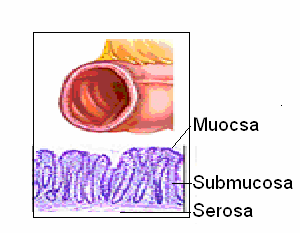Gastro-Intestinal Tract
Anatomy of the Gastro-Intestinal Tract
If you have been diagnosed with Crohn's Disease or Ulcerative Colitis you might ocasionally hear the names of those body parts where  the disease is localized. This section makes you understand which body part is meant.
The Gastrointestinal tract as a whole comprises of the entire food passage from the stomach to the intestines. Crohn's disease and Ulcerative Colitis can in priciple affect any part of the entire gastrointestinal tract, from mouth to anus.
the disease is localized. This section makes you understand which body part is meant.
The Gastrointestinal tract as a whole comprises of the entire food passage from the stomach to the intestines. Crohn's disease and Ulcerative Colitis can in priciple affect any part of the entire gastrointestinal tract, from mouth to anus.
The gastrointestinal tract consists of mouth, gullet (also called "esophagus"), stomach, and intestine. The intestine can be further divided into the small intestines and the large intestines. The large intestines simply refer to the colon. We can refine the classification even more and divide the small intestine is divided into three parts called "duodenum", "jejunum" and "ileum".
We have finally arrived at the "ileum", the part that is most important for our purposes. It is this section of the intestine which is the primary region affected by Crohn's disease. Sometimes the disease also spreads a bit further down the intestines and thus encroaches into the first part of the colon.
As you can imagine, the colon, is also divided into different parts, called "Caecum", "Ascending colon", "Transverse colon" and "Descending colon". With the "ileum" is the center point of the disease, Crohn's disease affecting the colon mostly affects the region right after the ileum, which is the "caecum" so the area involved is referred to as the "ileo-caecal" junction.
Fine Structure of gastro-intestinal Tract
 The entire Gastrointestinal tract is akin to a hollow tube through which the food passes. The wall of this tube-shaped tract is composed of four layers. From the inner-most the outer-most, they are called:
(a) Mucosa, (b) Submucosa, (c) Muscle layer, and (d) Serosa.
The entire Gastrointestinal tract is akin to a hollow tube through which the food passes. The wall of this tube-shaped tract is composed of four layers. From the inner-most the outer-most, they are called:
(a) Mucosa, (b) Submucosa, (c) Muscle layer, and (d) Serosa.
(a) The tissue on the inside surface of the tube through which the food glides is called the Mucosa. The mucosa covers the layers underneath it.
(b) The next layer, Submucosa, contains the blood vessels and nerves.
(c) The Muscle layer contains the muscle cells which can contract and relax, thereby propelling the food.
(d) The outermost layer is the Serosa, a "limiting" layer supporting and holding the organ together.